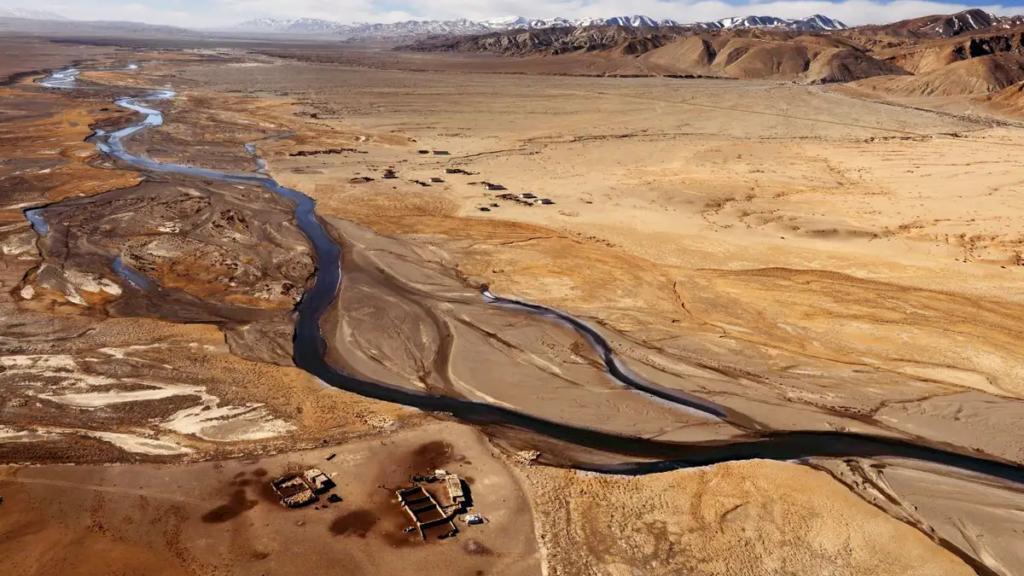
Early humans endured Earth’s harshest cold on Tibetan Plateau
The Tibetan Plateau, a region known for its rugged terrain and extreme climate, has long been considered one of the most inhospitable places on Earth. However, a new study has revealed that early humans not only survived but thrived on this unforgiving landscape during the last ice age. Archaeologists have uncovered a treasure trove of 427 artifacts, including tools and ochre, dating back to 29,000 to 23,000 years ago. This remarkable find highlights the resilience and adaptability of ancient humans, who faced extreme cold, low oxygen, and sparse vegetation during Earth’s harshest glacial period.
The Tibetan Plateau is a vast, high-altitude region that covers almost one-third of Asia. It is characterized by its extreme climate, with temperatures often plummeting to -40°C (-40°F) in winter and rising to 30°C (86°F) in summer. The region is also known for its low oxygen levels, making it a challenging environment for humans to survive. Despite these harsh conditions, early humans managed to not only survive but also thrive on this unforgiving landscape.
The discovery of 427 artifacts on the Tibetan Plateau is a significant finding, as it provides evidence of human presence in the region during the last ice age. These artifacts include tools, such as stone knives and scrapers, as well as ochre, a reddish-brown pigment made from iron oxide. The ochre is significant, as it was used by early humans to decorate their bodies and clothing, and its presence provides evidence of early human symbolic expression.
The artifacts were discovered at an altitude of over 4,500 meters (14,764 feet) above sea level, in a region known as the Nubra Valley. This valley is located in the northwestern part of the Tibetan Plateau, near the border with Pakistan and India. The region is known for its stunning natural beauty, with towering mountains, glaciers, and rivers.
The discovery of these artifacts is significant, as it provides evidence of human presence in the region during the last ice age. The last ice age, also known as the Pleistocene epoch, was a period of significant climate change, with glaciers covering much of the Northern Hemisphere. The Tibetan Plateau was particularly affected, with temperatures dropping to as low as -60°C (-76°F) and ice sheets covering much of the region.
Despite these extreme conditions, early humans managed to adapt to the harsh climate of the Tibetan Plateau. The artifacts discovered in the Nubra Valley provide evidence of human presence in the region during this period, and highlight the resilience and adaptability of ancient humans.
The discovery of these artifacts also provides insights into the daily lives of early humans on the Tibetan Plateau. The tools discovered, such as stone knives and scrapers, suggest that early humans were skilled hunters and gatherers, able to adapt to the harsh climate and limited resources of the region. The presence of ochre, a reddish-brown pigment, suggests that early humans were able to express themselves symbolically, using art and decoration to communicate and connect with one another.
The discovery of these artifacts also highlights the importance of the Tibetan Plateau as a hub for human migration and cultural exchange. The region’s unique geography, with its high-altitude mountains and glaciers, made it a critical pathway for human migration and cultural exchange. The discovery of these artifacts provides evidence of early human migration into the region, and highlights the importance of the Tibetan Plateau as a cultural and economic hub.
In conclusion, the discovery of 427 artifacts on the Tibetan Plateau provides evidence of early human presence in the region during the last ice age. The artifacts, including tools and ochre, suggest that early humans were able to adapt to the harsh climate and limited resources of the region, and highlight the resilience and adaptability of ancient humans. The discovery of these artifacts also provides insights into the daily lives of early humans on the Tibetan Plateau, and highlights the importance of the region as a hub for human migration and cultural exchange.
News Source:






